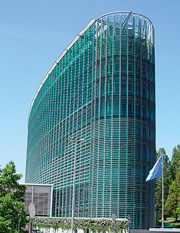The new International Standard ISO 23045:2008 will help the building sector to contribute to energy saving by providing it with specific design guidelines.
The building sector is recognized as a major contributor to the build-up of greenhouse gases. These emissions of CO2 to the atmosphere could be reduced significantly through the application of International Standards relating to the energy-efficient design of buildings and building mechanical equipment.

The objectives of the standard are to assist designers and practitioners when collecting and providing the useful data that are required at different stages of the design process and to fulfill building design objectives. ISO 23045:2008 applies to new buildings and is also applicable to systems for heating, cooling, lighting, domestic hot water, service water heating, ventilation and related controls.
Introducing energy efficiency in the design process leads to a reduction in energy demand through a global approach to the building, including analysis of the building location, definition of the building envelope, energy systems and products.
Mr Stephen Turner, leader of the ISO group that developed the standard, comments: "Today’s worldwide increase in efforts toward rational use of natural resources is increasing the markets for energy-efficient buildings and building equipment. The building sector holds great prospects for energy saving through the design of buildings with improved thermal performance and increased efficiency of mechanical equipment, as well of course through the entire range of buildings’ lifecycles. ISO 23045:2008 will help the building sector design buildings to a specified level of efficiency. It is an invaluable addition to the growing group of ISO standards for building environment design organized within the framework of ISO 16813, Building environment design — Indoor environment — General principles."
ISO 23045:2008 will assist in:
- collecting and providing information regarding the energy efficiency of the building under consideration
- conducting the iterative process to ensure improved energy efficiency of buildings
- obtaining the target values for energy efficiency ratios used in labelling or information to public or/and consumers.
ISO 23045:2008, Building environment design – Guidelines to assess energy efficiency of new buildings, was developed by ISO technical committee ISO/TC 205, Building environment design. It is available from ISO national member institutes (see the complete list with contact details). It may also be obtained directly from ISO Central Secretariat, price 96 Swiss francs through the ISO Store or by contacting the Marketing & Communication department (see right-hand column).
